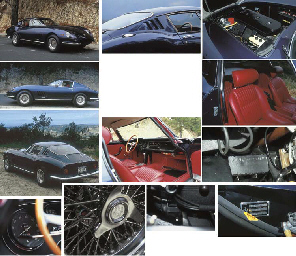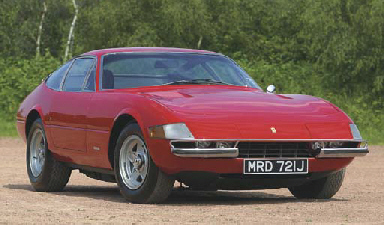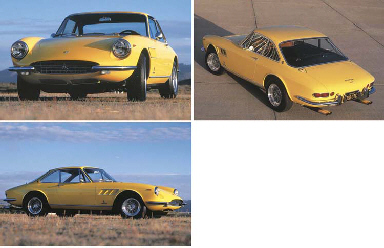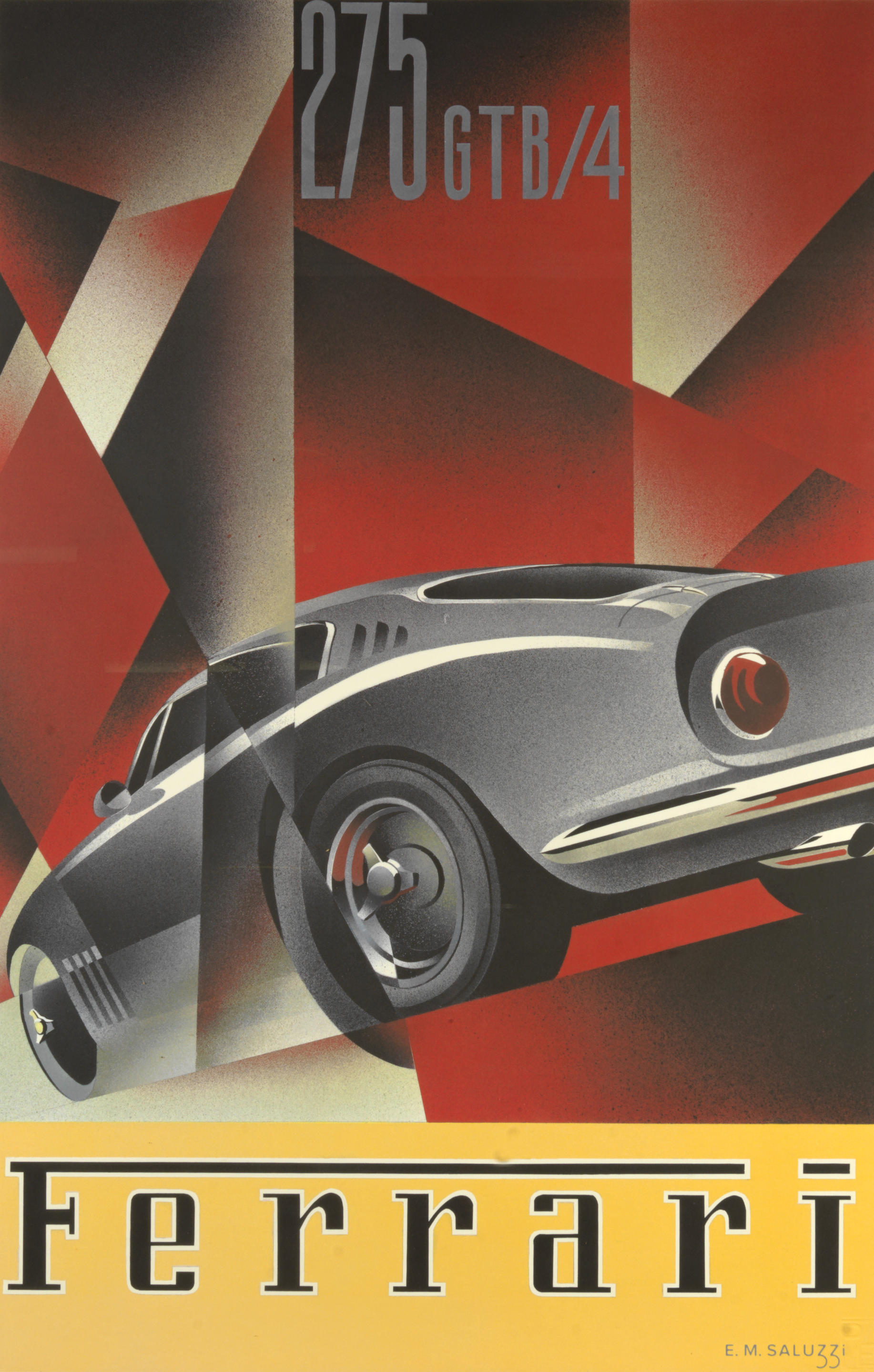3,286cc DOHC V-12 Engine Six Weber Carburetors 300bhp at 8,000rpm 5-Speed Manual Transaxle 4-Wheel Independent Suspension 4-Wheel Disc Brakes *Three owners from new *Full service records *Assembly sequence: no. 232 *Just over 500 miles on engine rebuild THE FERRARI 275 To the Ferraristi, those who revere the stable of the prancing horse above all other marques, so admired is the GTB/4 that mere mention of "four-cam Ferrari" invariably evokes outbursts of acclaim for the car's exquisite symmetry of visual and mechanical potency. To those fortunate enough to have driven a GTB/4, the sensation of being pulled toward a limitless horizon by the V-12's refined muscle will forever be engraved into their memories. Noted automotive journalist David E. Davis once said, "I firmly believe that everyone who is worth anything at all should own a 12-cylinder car before they die." It was likely he had a Ferrari V-12 in mind. Even a young Enzo Ferrari came to appreciate the V-12's alluring combination of power and smoothness. While recalling his first sight of a V-12, in a Packard in 1919, he remarked, "From that moment I married the V-12, and I never divorced it." More aggressive in appearance, the GTB's long hood, plexiglass-covered headlamps, laid-back cockpit, integrated rear spoiler and side vents were a vivid tribute to the all-conquering GTO race car. Its higher belt- and fender lines and rounded contours gave the 275 a commanding yet aerodynamic presence that conveyed its ability to slice powerfully through the atmosphere. Beneath the gorgeous body, penned by Batista Farina himself, was a tubular steel frame and mechanicals that reflected thirty years of racecar development. The first road Ferraris to have fully independent suspension, a rear-mounted transaxle for near 50-50 weight distribution, and the use of lightweight cast alloy wheels to reduce unsprung weight, its chassis and gearbox innovations were a direct adaptation of the developments that brought so much success to Enzo Ferrari with his sports/racing cars. The 5-speed rear-mounted transaxle had been utilized on the single-seat F1 and then on the sports/racing cars in the 1950s, and the 7x14-inch cast light alloy wheels recreated the design used on the 156 Formula One car of 1963. The 275 GTB/4 made its public debut at the 1966 Paris Auto Salon; thereafter, according to Ferrari, only 331 examples were built during the short production run that ceased in March of 1968 (it brought to an end by U.S. emissions standards that effectively eliminated Ferrari's most lucrative market). Model serial numbers range from no. 09007 to no. 11069; all were numbered in the odd chassis number road-car sequence; each chassis was identified with reference no. 596; and the car was offered in both left- and right-hand drive. Most GTB/4s were constructed of steel with aluminum doors, bonnet, and boot lid; a few were built entirely of aluminum. When new, a 275 GTB/4 cost between $16,000 and $17,000. Its overall shape was almost identical to preceding 275s, including the long nose, designed to reduce front-end lift, which was first introduced to the GTB in 1965, though with a flat bonnet instead of the first GTB's slightly raised profile. Thus the only easily seen visual difference from the 275 GTB (which was produced through 1966) was a slim and shallow central blister to accommodate a larger air filter housing. A second pair of vents, echoing those on the fenders, was cut into the sail panels to evacuate cabin air. European-spec models had different rear light lenses (an orange upper section for the turn signal and central circular reflector) from those bound to the U.S. (full red with a central horizontal rectangular reflector). Behind the angled windscreen was an interior that emulated other Ferrari-badged grand tourers of the era. Simple but elegant, the cabin's design featured a wraparound dashboard connected with the door panels, which featured aluminum inserts at the bottom. Four gauges fron
3,286cc DOHC V-12 Engine Six Weber Carburetors 300bhp at 8,000rpm 5-Speed Manual Transaxle 4-Wheel Independent Suspension 4-Wheel Disc Brakes *Three owners from new *Full service records *Assembly sequence: no. 232 *Just over 500 miles on engine rebuild THE FERRARI 275 To the Ferraristi, those who revere the stable of the prancing horse above all other marques, so admired is the GTB/4 that mere mention of "four-cam Ferrari" invariably evokes outbursts of acclaim for the car's exquisite symmetry of visual and mechanical potency. To those fortunate enough to have driven a GTB/4, the sensation of being pulled toward a limitless horizon by the V-12's refined muscle will forever be engraved into their memories. Noted automotive journalist David E. Davis once said, "I firmly believe that everyone who is worth anything at all should own a 12-cylinder car before they die." It was likely he had a Ferrari V-12 in mind. Even a young Enzo Ferrari came to appreciate the V-12's alluring combination of power and smoothness. While recalling his first sight of a V-12, in a Packard in 1919, he remarked, "From that moment I married the V-12, and I never divorced it." More aggressive in appearance, the GTB's long hood, plexiglass-covered headlamps, laid-back cockpit, integrated rear spoiler and side vents were a vivid tribute to the all-conquering GTO race car. Its higher belt- and fender lines and rounded contours gave the 275 a commanding yet aerodynamic presence that conveyed its ability to slice powerfully through the atmosphere. Beneath the gorgeous body, penned by Batista Farina himself, was a tubular steel frame and mechanicals that reflected thirty years of racecar development. The first road Ferraris to have fully independent suspension, a rear-mounted transaxle for near 50-50 weight distribution, and the use of lightweight cast alloy wheels to reduce unsprung weight, its chassis and gearbox innovations were a direct adaptation of the developments that brought so much success to Enzo Ferrari with his sports/racing cars. The 5-speed rear-mounted transaxle had been utilized on the single-seat F1 and then on the sports/racing cars in the 1950s, and the 7x14-inch cast light alloy wheels recreated the design used on the 156 Formula One car of 1963. The 275 GTB/4 made its public debut at the 1966 Paris Auto Salon; thereafter, according to Ferrari, only 331 examples were built during the short production run that ceased in March of 1968 (it brought to an end by U.S. emissions standards that effectively eliminated Ferrari's most lucrative market). Model serial numbers range from no. 09007 to no. 11069; all were numbered in the odd chassis number road-car sequence; each chassis was identified with reference no. 596; and the car was offered in both left- and right-hand drive. Most GTB/4s were constructed of steel with aluminum doors, bonnet, and boot lid; a few were built entirely of aluminum. When new, a 275 GTB/4 cost between $16,000 and $17,000. Its overall shape was almost identical to preceding 275s, including the long nose, designed to reduce front-end lift, which was first introduced to the GTB in 1965, though with a flat bonnet instead of the first GTB's slightly raised profile. Thus the only easily seen visual difference from the 275 GTB (which was produced through 1966) was a slim and shallow central blister to accommodate a larger air filter housing. A second pair of vents, echoing those on the fenders, was cut into the sail panels to evacuate cabin air. European-spec models had different rear light lenses (an orange upper section for the turn signal and central circular reflector) from those bound to the U.S. (full red with a central horizontal rectangular reflector). Behind the angled windscreen was an interior that emulated other Ferrari-badged grand tourers of the era. Simple but elegant, the cabin's design featured a wraparound dashboard connected with the door panels, which featured aluminum inserts at the bottom. Four gauges fron















Testen Sie LotSearch und seine Premium-Features 7 Tage - ohne Kosten!
Lassen Sie sich automatisch über neue Objekte in kommenden Auktionen benachrichtigen.
Suchauftrag anlegen